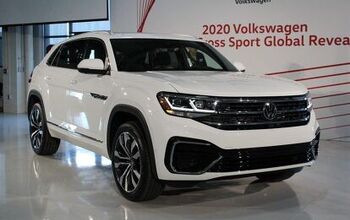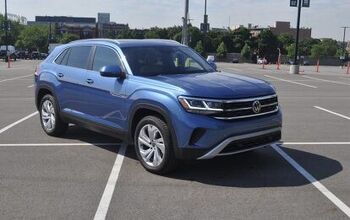2020 Volkswagen Atlas Cross Sport First Drive - Atlas Chopped

What happens to an OEM that may have been caught napping while its competitors race to fill every possible niche with crossovers?
It takes its three-row crossover, lops off the third row and some rear space, gives it a name that plays off the existing moniker, and puts it out there.
Hence we have the 2020 Volkswagen Atlas Cross Sport, which shares its platform with the Atlas (the wheelbases are even the same) but loses about three inches of length and a bit more than two inches of height while offering seating for just five.
(Full disclosure: Volkswagen flew me to Vancouver, fed and housed me, and had assembled media take part in off-site activities such as bobsledding and skiing. I did not take the proffered jacket.)
The biggest visual differences are a lowered roofline and a much more angular D-pillar (one that reminds me of the Jeep Grand Cherokee) along the rear hatch. The front lighting’s so-called “signature” is a bit different, too. The front bumper sweeps up at the corners, making the face match that of the upcoming, refreshed 2021 Atlas.
Inside, headroom is a bit reduced compared to the bigger Atlas, while legroom is increased – by a fair bit for those in the second row. There are about 40 cubic feet of cargo space behind the rear seats when they aren’t folded, which is about double that of the three-row with the rear seats up.
The cabin has the usual VW acres of black, with simple controls. The digital gauges look nice and are easy to read at a glance, which comes in handy when you’re a math-challenged American needing to keep an eye on your kilometers per hour.
[Get new and used Volkswagen Atlas Cross Sport pricing here!]
Two engines are offered, both available with all-wheel drive: A 2.0-liter turbocharged four-cylinder making 235 horsepower and 258 lb-ft of torque and a 3.6-liter V6 generating 276 horsepower and 266 lb-ft of torque. Both pair to an eight-speed automatic transmission. Non-AWD models are front-wheel drive. SEL and SEL Premium models can tow 5,000 pounds with a factory-installed hitch; otherwise, a dealer-installed hitch for other models allows up to 2,000 pounds of towing.
There’s a whole bunch of trims on offer: S, SE, SE with Technology, SE with Technology and R-Line, SEL, SEL R-Line, SEL Premium, and SEL Premium R-Line.
I spent the first part of my day on the gently curving Sea to Sky highway in an SEL Premium V6 with AWD. The first thing I noticed was the extremely light steering – which seems to be a hallmark of non-sporty VWs these days. We’re talking Kozy Koupe light here. A flick into Sport mode helps, but only a bit.
Despite this, the Cross Sport felt a bit livelier in handling, especially in Sport mode, than the last three-row Atlas I drove. About as lively as things could get on the Sea to Sky – the road’s corners aren’t particularly challenging. As with the Hyundai Venue, I’d like some further testing.
The V6 pulled nicely, but the eight-speed displayed some hesitant behavior when called upon to downshift. Overall, the experience was on the sportier side for a five-seat crossover, but you’re still aware you’re driving a crossover. At least body roll was well muted. Ride was comfortable in Sport and Normal modes, but potholes and rough road weren’t really a challenge.
A four-cylinder SEL with AWD handled and rode similarly, and offered up a pleasant surprise – the turbo-four got up to speed with an urgency I didn’t expect. And the eight-speed was smoother and crisper, for whatever reason.
The SEL Premium comes at a price. Both vehicles were well-equipped, with standard features in the SEL Premium including 20-inch wheels, adaptive front lighting, fog lamps, dual-zone climate control, heated and cooled front seats, leather seats, heated outboard rear seats, Apple CarPlay, Android Auto, nav, adaptive cruise control, blind-spot monitoring, rear cross-traffic alert, park assist, park distance control, forward-collision warning, autonomous emergency braking with pedestrian monitoring, lane-keeping assist, traffic-jam assist, rear power liftgate, Bluetooth, and wireless charger.
With the only options being the paint job and rubber floor mats, plus a $1,020 destination fee, this version of the Cross Sport cost $49,745.
That’s a lot more than a loaded Honda Passport – which, to be fair, rides on the aging Pilot platform, and in line with the upper trims of the (also aging rapidly) Jeep Grand Cherokee in V6 guise.
This is why I might tell a friend who’s considering the Cross Sport to consider a four-cylinder SEL. Similarly equipped, the four-banger SEL I drove cost $42,700. Not to mention that the trip computer showed much better fuel economy numbers after my stint in the four, despite an uphill climb into the mountains.
There are too many trim combinations to list full pricing here, but the base price of entry is $30,545 for a FWD S and $37,345 for the most basic V6 you can get – a SE with tech. The most expensive four-cylinder starts at $47,995, while the priciest Cross Sport is a V6 AWD that checks in at $49,795.
Standard features include 18-inch wheels, roof rails, LED lights all around, heated side mirrors, automatic headlights, rain-sensing wipers, two USB ports, blind-spot monitor, and rear cross-traffic alert.
Fuel economy is listed at 21 mpg city/24 mpg highway/22 mpg combined for FWD four-cylinders and 18/23/20 for those with AWD. With the V6, it’s listed at 17/23/19 and 16/22/19 with AWD.
If the Atlas strikes your fancy but you don’t need a third row, the Cross Sport is a fine ride, though I’m not sure if it provides much reason to step up from the smaller Tiguan unless you need the extra space – and comparing specs, the Tiguan comes close in some interior measurements. It’s also available with three rows, for what it’s worth.
The harder part is placing the Cross Sport in the universe of the mid-size, five-seat crossover class. I’d take it over Ford’s Edge or Chevy’s Blazer (depending on trim), and it’s about on par with the Grand Cherokee V6, and perhaps a notch below the Passport. It’s not the first crossover I’d plunk a down payment on, but I’d not be ashamed to own one. It’s somewhere in the middle/upper-middle of a crowded pack.
It helps that VW was starting with a solid base in the three-row Atlas. The trick is to option the Cross Sport the right way. While the V6 offers more grunt, the four-cylinder should suit most needs. Be careful with the option boxes.
Atlas may or may not have shrugged, but a chopped Atlas will carry the load solidly, if not spectacularly.
[Images © 2020 Tim Healey/TTAC]

Tim Healey grew up around the auto-parts business and has always had a love for cars — his parents joke his first word was “‘Vette”. Despite this, he wanted to pursue a career in sports writing but he ended up falling semi-accidentally into the automotive-journalism industry, first at Consumer Guide Automotive and later at Web2Carz.com. He also worked as an industry analyst at Mintel Group and freelanced for About.com, CarFax, Vehix.com, High Gear Media, Torque News, FutureCar.com, Cars.com, among others, and of course Vertical Scope sites such as AutoGuide.com, Off-Road.com, and HybridCars.com. He’s an urbanite and as such, doesn’t need a daily driver, but if he had one, it would be compact, sporty, and have a manual transmission.
More by Tim Healey
Latest Car Reviews
Read moreLatest Product Reviews
Read moreRecent Comments
- Fahrvergnugen The only GP we watch - and attend - is SailGP. Feeds a slightly different bunch of adrenaline junkies, though there must be some overlap.
- SCE to AUX Fisker filed for reorganization in Austria - the end is near.https://insideevs.com/news/718875/fisker-reorganization-austria/
- Bd2 I'll watch F1 when Kia and/or Hyundai pony (pun intended) up the cash to field a class leading team. Hyundai is leading many series with the Elantra N with it's incredible 350HP Smartstream-N engine.
- MaintenanceCosts More or less an admission that the radar-only cars will never do anything that could reasonably be marketed as "Full Self-Driving."
- Bd2 The coolest true SUV on the market. Change my mind.








































Comments
Join the conversation
Ford Edge by Mitsubishi. No.
The very embodiment of a pointless and useless model.